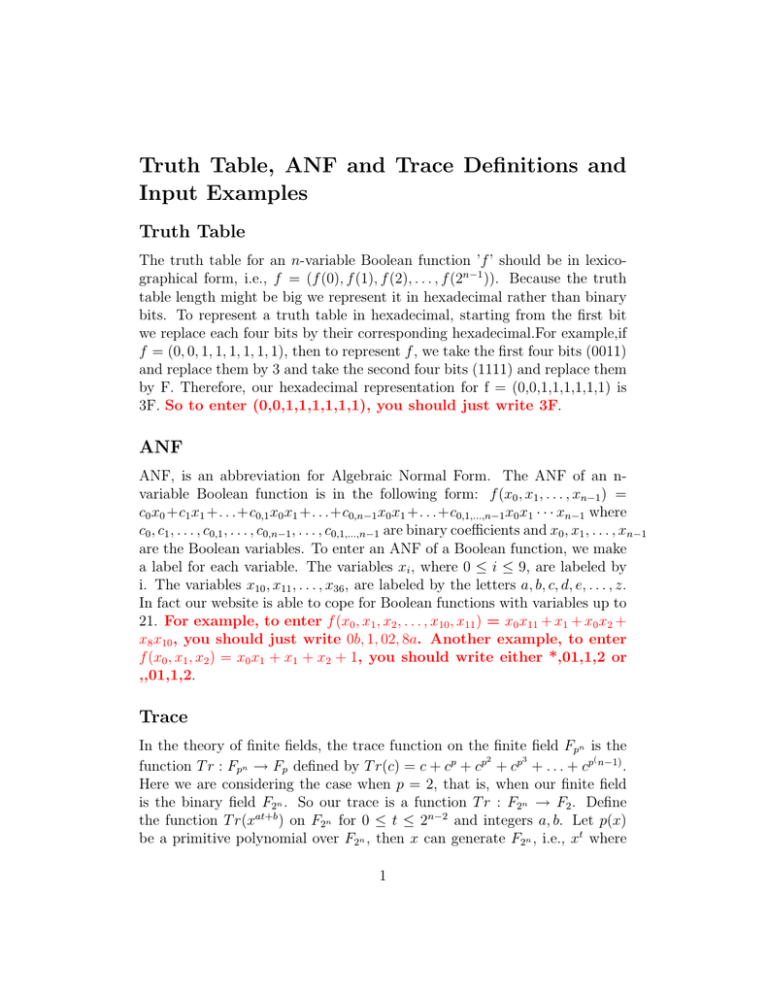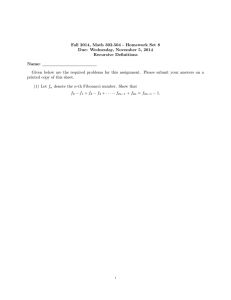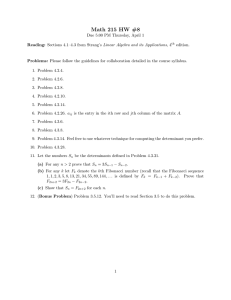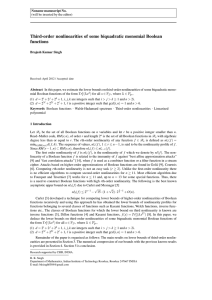Truth Table, ANF and Trace Definitions and Input Examples
advertisement

Truth Table, ANF and Trace Definitions and Input Examples Truth Table The truth table for an n-variable Boolean function ’f ’ should be in lexicographical form, i.e., f = (f (0), f (1), f (2), . . . , f (2n−1 )). Because the truth table length might be big we represent it in hexadecimal rather than binary bits. To represent a truth table in hexadecimal, starting from the first bit we replace each four bits by their corresponding hexadecimal.For example,if f = (0, 0, 1, 1, 1, 1, 1, 1), then to represent f , we take the first four bits (0011) and replace them by 3 and take the second four bits (1111) and replace them by F. Therefore, our hexadecimal representation for f = (0,0,1,1,1,1,1,1) is 3F. So to enter (0,0,1,1,1,1,1,1), you should just write 3F. ANF ANF, is an abbreviation for Algebraic Normal Form. The ANF of an nvariable Boolean function is in the following form: f (x0 , x1 , . . . , xn−1 ) = c0 x0 +c1 x1 +. . .+c0,1 x0 x1 +. . .+c0,n−1 x0 x1 +. . .+c0,1,...,n−1 x0 x1 · · · xn−1 where c0 , c1 , . . . , c0,1 , . . . , c0,n−1 , . . . , c0,1,...,n−1 are binary coefficients and x0 , x1 , . . . , xn−1 are the Boolean variables. To enter an ANF of a Boolean function, we make a label for each variable. The variables xi , where 0 ≤ i ≤ 9, are labeled by i. The variables x10 , x11 , . . . , x36 , are labeled by the letters a, b, c, d, e, . . . , z. In fact our website is able to cope for Boolean functions with variables up to 21. For example, to enter f (x0 , x1 , x2 , . . . , x10 , x11 ) = x0 x11 + x1 + x0 x2 + x8 x10 , you should just write 0b, 1, 02, 8a. Another example, to enter f (x0 , x1 , x2 ) = x0 x1 + x1 + x2 + 1, you should write either *,01,1,2 or ,,01,1,2. Trace In the theory of finite fields, the trace function on the finite field Fpn is the 3 ( 2 function T r : Fpn → Fp defined by T r(c) = c + cp + cp + cp + . . . + cp n−1) . Here we are considering the case when p = 2, that is, when our finite field is the binary field F2n . So our trace is a function T r : F2n → F2 . Define the function T r(xat+b ) on F2n for 0 ≤ t ≤ 2n−2 and integers a, b. Let p(x) be a primitive polynomial over F2n , then x can generate F2n , i.e., xt where 1 0 ≤ t ≤ 2n − 2 are all nonzero the elements of F2n . From the theory of finite fields, we know that each element in F2n can be represented by a binary string of length n, and we also know that F2n consists of all the possible binary strings of length n. This means that for each value of xt , we have a corresponding binary string. By evaluating T r(xat+b ) for 0 ≤ t ≤ 2n−2 , we obtain 2n − 1 binary values. Now, for each t, let T r(xat+b ) be an element in the truth table at the position corresponding to the decimal representation of the binary string corresponding to the element xt . Now, if we set a value at position 0, we will have a complete truth table. This value can be either true or false, but by convention we set it as false.The general form of the trace function we are dealing with, is T r(xa1 t+b1 ) + T r(xa2 t+b2 ) + T r(xa3 t+b3 ) + . . . + T r(xak t+bk ), where a1 , a2 , a3 , . . . , ak are different integers. We enter it in the following form a1 , b1 /a2 , b2 /a3 , b3 / . . . /ak , bk . There is a restriction on the values of b1 , b2 , b3 , . . . , bk depending on a1 , a2 , a3 , . . . , ak respectively. In the trace calculations, you need to enter a primitive polynomial p(x). We have a simple way to enter it, by typing the number of variables in the primitive polynomials textbox, n, you will immediately see a list containing all the primitive polynomials of degree n from which you can select your primitive polynomial. For example, to enter T r(x3t+2 ) + T r(x2t ), you should just write 3,2/2,0. 2


